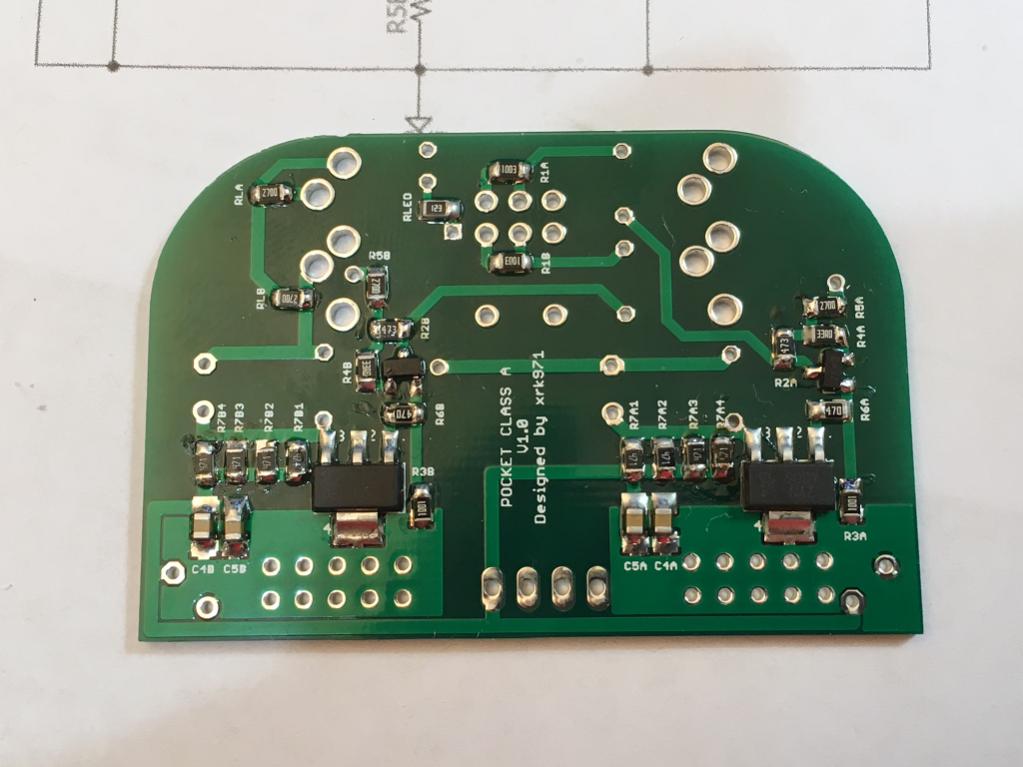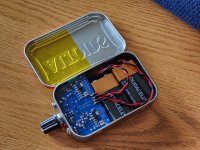Finally (hopefully), I was wondering what the Manufacturers part number is for the Nichicon 16V 2200uF cap (C3)?
There are a few different ones on the mouser website, so I want to make sure I order the correct one.
I already have the Panasonic ones listed on the BOM but as I am having to order more parts anyway and they are recommended, then I thought I would add them to the list.
There are a few different ones on the mouser website, so I want to make sure I order the correct one.
I already have the Panasonic ones listed on the BOM but as I am having to order more parts anyway and they are recommended, then I thought I would add them to the list.
Hi Paul,
I was able to snag a couple of the Wima caps from Newark Electronics. Not sure if that helps where you are located. Good luck with your build.
Dave M.
I was able to snag a couple of the Wima caps from Newark Electronics. Not sure if that helps where you are located. Good luck with your build.
Dave M.
Finally (hopefully) I noticed that for C3 a Nichicon 2200uF 16V is highly recommended. I already have the Panasonic 100uF from the BOM but as I am ordering new parts I might as well add the Nichicon's to the list.
There appear to be a few different types of 16V 22uF Nichicon's when I check the Mouser website. Can somebody tell me what Manufacturer part number I need for this amp?
Thanks
Paul
There appear to be a few different types of 16V 22uF Nichicon's when I check the Mouser website. Can somebody tell me what Manufacturer part number I need for this amp?
Thanks
Paul
I also noticed that post 2,189 showed one side of the low impedance version (which is what I am about to attempt).
Would it be possible to post a picture of the other side of the board?
I am still very new to this, so it's always useful to have a quick visual reference to make sure I am on the right track.
Thanks
paul
The other side looks same as what’s on post 1.

Thanks for all the helpful replies, it's appreciated.
The only outstanding issue was my question about replacing a Wima cap with a Vishay. Will there be an audible difference?
The only outstanding issue was my question about replacing a Wima cap with a Vishay. Will there be an audible difference?
I was about to start my build and then, once I went through all my parts labelling them, realised I didn't have the Wima caps.
The 2.2uF Wima's are readily available but the 1uF are out of stock at all the usual UK suppliers. Would a Vishay cap (BFC237011105) be ok as a replacement?
Hey Folks,
Another Pocket Class A HPA is up and running, sort of. (I built the low impedance version).
When purchasing rail caps there were several variations of the Nichicon 2200uF 16v to choose from. I chose one that unfortunately is a little too large. As a result, the pcb rides too high in the Altoids tin and if I solder the Wima 1uf's to the back side I can't get the lid shut. Whoops!
So I am running it without the Wima's temporarily. Would this be an issue with long term use? I should have paid closer attention to the physical dimensions of the rail caps prior to ordering them. I may need to order a different variation and replace them. By the way, the amp sounds very good even without the Wima 1uf's installed on the SMT side.
Another Pocket Class A HPA is up and running, sort of. (I built the low impedance version).
When purchasing rail caps there were several variations of the Nichicon 2200uF 16v to choose from. I chose one that unfortunately is a little too large. As a result, the pcb rides too high in the Altoids tin and if I solder the Wima 1uf's to the back side I can't get the lid shut. Whoops!
So I am running it without the Wima's temporarily. Would this be an issue with long term use? I should have paid closer attention to the physical dimensions of the rail caps prior to ordering them. I may need to order a different variation and replace them. By the way, the amp sounds very good even without the Wima 1uf's installed on the SMT side.
Attachments
Congrats Uncle Mudd!
The 1uF film bypass cap is optional. You may or may not hear a difference.
The 1uF film bypass cap is optional. You may or may not hear a difference.
You may want to switch to rechargeable 9v batteries. The Class A chews through it pretty fast. 2.5hrs typically.
I have a little bit of work to run some simulations of the Diamond buffer to optimize for lower impedance headphones. The layout is all there and now tweak the setpoints with choice of resistors to get the best performance possible.
I have a little bit of work to run some simulations of the Diamond buffer to optimize for lower impedance headphones. The layout is all there and now tweak the setpoints with choice of resistors to get the best performance possible.
Last edited:
A tip on JST and Molex connectors is order clones in a kit from Amazon or Aliexpress.
For example:
https://a.co/d/8s8AUf8
For example:
https://a.co/d/8s8AUf8
Thanks for the tip, I will look into that.
Also, I ordered the rechargable batteries recommended in prior posts from Amazon. They're charging as we speak.
Also, I ordered the rechargable batteries recommended in prior posts from Amazon. They're charging as we speak.
Great. Note that the 9v rechargeable a have a smart safety circuit inside - actually a very sophisticated current monitor and solid state relay mosfet eFuse. This cuts off current to prevent a fire in case high currents are detected. When you initially turn on, a large startup current flows to charge the rail caps. The battery shuts down. So click the on off button quickly on off a few times. Each time it charges the caps more until no more in rush that triggers auto power off.
Usually 3 clicks on/off/on does it.
Usually 3 clicks on/off/on does it.
The Pocket Diamond Buffer Class A amp in Altoids tin is now a reality.



Testing worked great from first power up. Amp is DC coupled output so no coupling caps to get in the way of the sound.



With current setpoints the bias current is a bit high at 75mA. Open air temps of outputs are 75C. With silicone thermal pads conducting to the lid temps were 45C. I think I am going to have to readjust the bias current back down to the design setpoint of 45mA.
The sound is amazing though. Drives inefficient HiFiman HE-400i very well and can get super loud. Predicted performance is 1W into 32ohms capability with 0.11% THD. At modest 4mW, THD is predicted to be in 0.0007% range.
Testing worked great from first power up. Amp is DC coupled output so no coupling caps to get in the way of the sound.
With current setpoints the bias current is a bit high at 75mA. Open air temps of outputs are 75C. With silicone thermal pads conducting to the lid temps were 45C. I think I am going to have to readjust the bias current back down to the design setpoint of 45mA.
The sound is amazing though. Drives inefficient HiFiman HE-400i very well and can get super loud. Predicted performance is 1W into 32ohms capability with 0.11% THD. At modest 4mW, THD is predicted to be in 0.0007% range.
Last edited:
Here is schematic of the diamond buffer output stage. The output is nested in a composite amp with voltage gain provided by an opamp and negative feedback to the opamp input. Overall gain is set at 12dB.

Predicted 1Vpp into 32ohms with 42mA bias current gives 0.0007% THD:

For 5.65Vrms into 32 ohms (1W) we get 0.11% THD but still monotonically descending harmonic distortion profile:

Detail of PCBA all SMT buffer side:

Closeup of bottom side with opamp buffer and all where all TH parts mount:

Final assembly of remaining TH parts is really easy: volume pot, 2 input caps, 3.5mm jacks, 4pin JST, 4x 100uF electrolytic rail caps.
Let me know if you guys are interested in a GB for this board.
Predicted 1Vpp into 32ohms with 42mA bias current gives 0.0007% THD:
For 5.65Vrms into 32 ohms (1W) we get 0.11% THD but still monotonically descending harmonic distortion profile:
Detail of PCBA all SMT buffer side:
Closeup of bottom side with opamp buffer and all where all TH parts mount:
Final assembly of remaining TH parts is really easy: volume pot, 2 input caps, 3.5mm jacks, 4pin JST, 4x 100uF electrolytic rail caps.
Let me know if you guys are interested in a GB for this board.
- Home
- Group Buys
- xrk971 Pocket Class A Headamp GB
